



The Comacine masters (magistri comacini) were early medieval Lombard stonemasons working in a region of excellent building stone who gave to Lombardy its preeminence in the stone architecture that preceded Romanesque style.




The Comacine masters (magistri comacini) were early medieval Lombard stonemasons working in a region of excellent building stone who gave to Lombardy its preeminence in the stone architecture that preceded Romanesque style.
Their masons' marks have suggested arcane meanings for some enthusiasts. The name comacini Romantic historians of the nineteenth century traced to the location where they supposedly had their headquarters, the minute Isola Comacina in Lake Como, alleged to have been a safe haven during the Lombard invasion; a more inventive etymology derives from a supposed Latin expression cum machinis, referring to their tools. [1]
The first mention of Comacine masters was in an edict of 643 of the Lombard king Rothari, which concerned itself in Lombard fashion mainly with the indemnity that would be due should a house collapse which had been built by a magister comacinus for a patron ad opera dictandi ("commissioning the works"). [2] The reference has been interpreted as granting certain privileges to magistri comacini, but the context shows that modern readers are correct in interpreting the key word comacini simply as "masons". Comacini are also mentioned in a passage in the Memoratorium of Liutprand the Lombard.
The survival of brotherhoods of the comacini are based on the hypothesis [3] that the Roman secrets of masonry construction were never utterly lost in Italy but were passed on by the mason brotherhoods, which were supposed to be among the numerous documented collegii in which workingmen joined together for mutual protection, fraternal banqueting and eventual support of their widows throughout the Roman Empire, sometimes associated together as masters of the arcana or "mysteries" of their craft. Each such confraternity was composed of men (never women) located in a single town, and was made up of men of a single craft or those worshipping a single deity, free, freedmen and slaves together, forming a bond very like the image of a city, always under the uneasy surveillance of officialdom. [4] Such, it supposed, were the comacini whose geographical center in the Early Middle Ages originated in Lombardy, in Como and Pavia.
If mason's marks were the sign of the comacini, then evidence of their work has been found in several parts of Europe, as far as the capitals of the crypt in the cathedral of Lund. The "Como-Pavian" architectural sculpture is recognized in the cathedral of Modena and its Torre della Ghirlandina, [5] in central [6] and southern Italy, west across Languedoc to Iberian Peninsula, across southern Germany as far as Hungary, and even in England. [7]
In the Middle Ages, artists did not customarily sign their work, so to detect the work of this corporation, historians look to masons' marks inscribed in the stonework; in this way historians have traced comacine master's influence as far as Sweden and Syria. Freemasons claimed descent from the guilds of comacini. [8]
The efflorescence of a "Como-Pavian" school of sculptural decoration on pulpits and portals that surfaced in the area of Como in the late eleventh century and developed luxuriously to enrich facades in Pavia in the 1130s, then were disseminated more widely in the twelfth and thirteenth century, doubtless by travelling groups of artisans, is traditionally ascribed to a surfacing of a long-buried tradition of comacini sculptors, who were influenced by the animal interlaces of Lombard metalwork. [9] In this corrente comasca that spread on the periphery of Romanesque and Early Gothic art, geometric interlaces are peopled with sleek monsters and figures that seem to synthesize some very disparate and distant influences: barbaric Longobard metalwork, Ottonian illuminations, Byzantine silk patterns, Islamic patterning, Coptic reliefs, have all been compared to the "Como-Pavian" current of sculpture. [10]
Another notable group of medieval stoneworkers were maestri Campionesi from Campione, not far from Como.
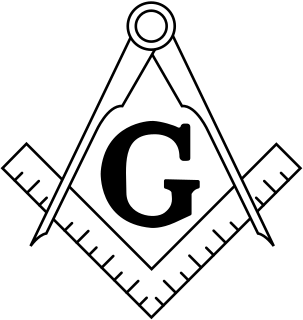
Freemasonry or Masonry consists of fraternal organisations that trace their origins to the local fraternities of stonemasons that from the end of the 14th century regulated the qualifications of stonemasons and their interaction with authorities and clients. Freemasonry has been the subject of numerous conspiracy theories throughout the years. Modern Freemasonry broadly consists of two main recognition groups:
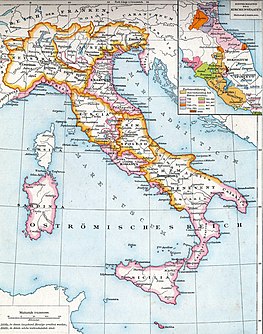
The Lombards or Langobards were a Germanic people who ruled most of the Italian Peninsula from 568 to 774.
The history of Freemasonry encompasses the origins, evolution and defining events of the fraternal organisation known as Freemasonry. It covers three phases. Firstly, the emergence of organised lodges of operative masons during the Middle Ages, then the admission of lay members as "accepted" or "speculative" masons, and finally the evolution of purely speculative lodges, and the emergence of Grand Lodges to govern them. The watershed in this process is generally taken to be the formation of the first Grand Lodge in London in 1717. The two difficulties facing historians are the paucity of written material, even down to the 19th century, and the misinformation generated by masons and non-masons alike from the earliest years.

Lake Como, also known as Lario, is a lake of glacial origin in Lombardy, Italy. It has an area of 146 square kilometres (56 sq mi), making it the third-largest lake in Italy, after Lake Garda and Lake Maggiore. At over 400 metres (1,300 ft) deep, it is the fifth deepest lake in Europe, and the deepest outside Norway; the bottom of the lake is more than 200 metres (660 ft) below sea level.

Lombard is a language spoken by millions of speakers in Northern Italy and Southern Switzerland, including most of Lombardy and some areas of neighbouring regions, notably the eastern side of Piedmont and the western side of Trentino, and in Switzerland in the cantons of Ticino and Graubünden. Within the Romance languages, they form part of the Gallo-romance group.

Bellagio is a comune (municipality) in the Province of Como in the Italian region of Lombardy. It is located on Lake Como, also known by its Latin-derived name Lario, whose arms form an inverted Y. The triangular land mass at the base of the inverted Y is the Larian Triangle: at its northern point sits Bellagio, looking across to the northern arm of the lake and, behind it, the Alps. It has always been famous for its location. It belongs to a mountain community named Comunità montana del Triangolo lariano, with base in Canzo.

A mason's mark is a symbol often found on dressed stone in buildings and other public structures.
The Order of the Blessed Virgin Mary, also called the Order of Saint Mary of the Tower or the Order of the Knights of the Mother of God, commonly the Knights of Saint Mary, was a military order founded in 1261. The order received its rule from Pope Urban IV, who expressly states the purpose of the organisation and the rights and obligations of its members:
[The members of the order] are to be allowed to bear arms for the defence of the catholic faith and ecclesiastical freedom, when specifically required to do so by the Roman church. For subduing civil discords they may carry only defensive weapons, provided they have the permission of the diocesan.
Sabina von Steinbach was – according to legend – a female stonemason living in Alsace during the 13th century. She is said to have been the daughter of Erwin von Steinbach, architect and master builder at Notre-Dame de Strasbourg, the cathedral in Strasbourg. When after her father's death her brother Johann continued to build the cathedral tower from 1318 to 1339, Sabina is believed to have been employed as a skillful mason and sculptor in its completion. There are, however, strong doubts as to whether she existed.

There are Masonic degrees named after the Knights Templar but not all Knights Templar Orders are Masonic.

One of the first streams of Romanesque architecture in Europe from the 10th century and the beginning of 11th century is called First Romanesque or Lombard Romanesque. It took place in the region of Lombardy and spread into Catalonia and into the south of France. Its principal decoration for the exterior, bands of ornamental blind arches are called Lombard bands. It was characterized by thick walls and lack of sculpture in facades, and with interiors profusely painted with frescoes.
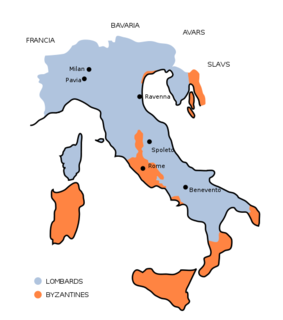
The Kingdom of the Lombards also known as the Lombard Kingdom; later the Kingdom of (all) Italy, was an early medieval state established by the Lombards, a Germanic people, on the Italian Peninsula in the latter part of the 6th century. The king was traditionally elected by the highest-ranking aristocrats, the dukes, as several attempts to establish a hereditary dynasty failed. The kingdom was subdivided into a varying number of duchies, ruled by semi-autonomous dukes, which were in turn subdivided into gastaldates at the municipal level. The capital of the kingdom and the center of its political life was Pavia in the modern northern Italian region of Lombardy.
There are a number of masonic manuscripts that are important in the study of the emergence of Freemasonry. Most numerous are the Old Charges or Constitutions. These documents outlined a "history" of masonry, tracing its origins to a biblical or classical root, followed by the regulations of the organisation, and the responsibilities of its different grades. More rare are old hand-written copies of ritual, affording a limited understanding of early masonic rites. All of those which pre-date the formation of Grand Lodges are found in Scotland and Ireland, and show such similarity that the Irish rituals are usually assumed to be of Scottish origin. The earliest Minutes of lodges formed before the first Grand Lodge are also located in Scotland. Early records of the first Grand Lodge in 1717 allow an elementary understanding of the immediate pre-Grand Lodge era and some insight into the personalities and events that shaped early-18th-century Freemasonry in Britain.
Continental Freemasonry, also known as Liberal Freemasonry, Latin Freemasonry and Adogmatic Freemasonry, includes the Masonic lodges, mainly on the continent of Europe, that recognise the Grand Orient de France (GOdF) or belong to CLIPSAS. The majority of Freemasons belong to lodges that recognise the United Grand Lodge of England[citation needed] and do not recognise Continental Freemasons, regarding them as "irregular".
Central Italian flagellant confraternities evolved and emerged from Central Italian confraternities that originated in the tenth century. The members of these original confraternities were lay persons who were devoted to religious life.
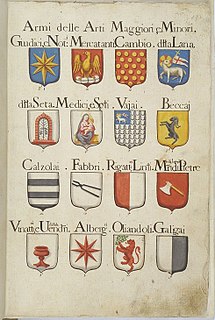
The guilds of Florence were secular corporations that controlled the arts and trades in Florence from the twelfth into the sixteenth century. These Arti included seven major guilds, five middle guilds and nine minor guilds. Their rigorous quality control and the political role in the commune that the Arti Maggiori assumed were formative influences in the history of Florence, which became one of the richest cities of late Medieval Europe.

Art in Medieval Scotland includes all forms of artistic production within the modern borders of Scotland, between the fifth century and the adoption of the Renaissance in the early sixteenth century. In the early Middle Ages, there were distinct material cultures evident in the different federations and kingdoms within what is now Scotland. Pictish art was the only uniquely Scottish Medieval style; it can be seen in the extensive survival of carved stones, particularly in the north and east of the country, which hold a variety of recurring images and patterns. It can also be seen in elaborate metal work that largely survives in buried hoards. Irish-Scots art from the kingdom of Dál Riata suggests that it was one of the places, as a crossroads between cultures, where the Insular style developed.
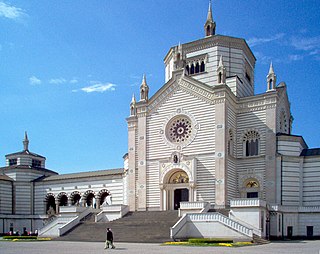
Carlo Francesco Maciachini was an Italian architect and restorer. Born near Varese, he studied in Milan, where he also realized some of his most important works, most notably the Monumental Cemetery (1866). Other notable works of Maciachini are restorations of historic churches in several cities of northern Italy.
Antonio della Porta, better known as Tamagnino was an Italian sculptor of the Renaissance.
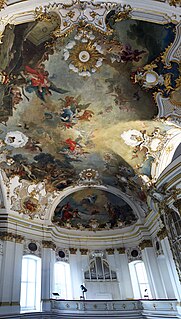
Livio Retti was an Italian Baroque painter who worked mainly in present-day South Germany, at the time the Duchy of Württemberg, the Duchy of Bavaria, some secular or ecclesiastical franconians principalities and some free imperial cities such as Schwäbisch Hall for example.